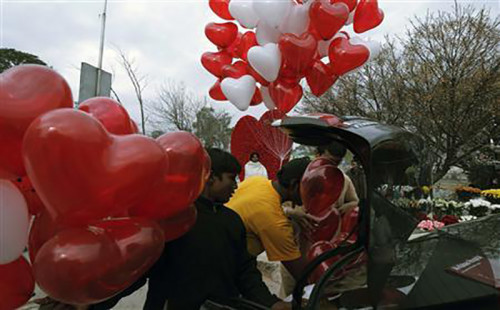Valentine schmalentine

Call it age or cynicism, but every year as we
draw closer to Valentine’s Day, the incessant inescapable marketing makes me
feel much like Dr Seuss’s Grinch who stole Christmas or Dicken’s Ebenezer
Scrooge going around shouting “Bah! Humbug!” Though in my case, it is
Valentine’s Day and not Christmas that has me shaking my head.
So I never thought I would say this, but I
think I am missing the usual build up that precedes February 14. A year of
Covid-19 and lockdowns has made me yearn for the saccharine sweet adverts on
television and radio plugging gift ideas, candlelit dinners, or romantic
getaways for the special someone in our lives. I long for the days where I
could walk into a departmental store or a shop on the high street and roll my
eyes at heart-shaped chocolate boxes and grumble at the sudden doubling of the
prices of roses for that day only.
It is not that I have anything against
romantic gestures, far from it. And kudos to those celebrating or expressing
themselves romantically in a year full of uncertainty, grief, and loss. Finding
joy in these worrying times is a gift in itself.
But proclaiming one’s love or affection on a
given day feels like a bit of a cop out if it “buys” you a free pass for the
364 days of the year remaining. That, and the fact that it puts an inordinate
amount of pressure on people to conform and leaves them scrambling to think of
novel gift ideas or making extravagant gestures because they feel they have to
observe the “special day.” Obviously I am a die-hard cynic, having written, “we
have moved on from the ideology of it’s the thought that counts to the concept
of how much did your thought cost” over a decade ago.
In 2020, people spent an average of 35 pounds resulting in a total of almost 1.45 billion pounds in the UK alone on Valentine’s Day, with dining out as the most popular choice. This year with the closing of shops, restaurants, hotels, cafes, bars, and widespread travel bans in place while we ride out this pandemic, there has been little in the way of ideas to mark the day. So far, from what I can ascertain, the only offerings on social media or various search engines appear to be online gifts which have become part of the new normal.
Unsurprisingly, the restrictions have impacted total expenditure this year, bringing it down to 926 million pounds, or 23 pounds per person. It appears Generation Z is the age group leading the charge with respect to spending money (41 pounds) on their loved ones while my squad, Generation X, is lagging behind the Millennials with a paltry of 19 pounds, but ahead of the Baby Boomers.
With many couples being separated due to lockdown restrictions, there are people who may end up celebrating the day virtually on video calls, while others may do something as simple as going for walks together. It is thought that 24% of people in Britain will not be celebrating Valentine’s Day today. If sitting in pyjamas watching Netflix counts as celebrating then sign me up, preferably with a takeaway. Otherwise, I may have to add my name to the 24%.
It is also worth remembering the different
stories attached to the origins of Valentine’s Day which are not all about
chocolate and flowers and not even about love.
One version and possibly the earliest origin story is that it was a pagan holiday in Ancient Rome. Lupercalia was a feast to a heathen God when boys and girls were separated. However, the young people had a custom that began on the eve of Lupercalia. Girls’ names were written on pieces of paper and placed into jars. Each boy then drew a girl’s name from the jar and the two were partnered throughout the festival.
After being paired, the young couple would often continue to see each other throughout the year and on occasion even fell in love and got married. A less idyllic story suggests men would strip naked and sacrifice a goat and a dog. Bits of the hide from these animals would be used to whip young women to promote fertility. In the late 5th century, this unsavoury pagan ritual was ended by Pope Gelasius.
Another story involves a saint named Valentine. He was arrested and brought before Emperor Claudius II of Rome during one of the many persecutions of Christians. When St. Valentine refused to renounce his faith, he was executed on the February 14, but prior to this he was said to have restored the sight of his jailer’s daughter. He then wrote a letter to her and signed it “From your Valentine,” thus coining the phrase of being someone’s Valentine.
Another claims that Claudius II thought it was
it difficult to recruit men as soldiers when they were either married or had
sweethearts as they did not want to leave their loved ones, so he cancelled all
engagements and marriages throughout Rome. St Valentine was believed to have
married couples in secret. He was eventually caught, arrested, and condemned.
He was beaten to death and beheaded on February 14, around the year AD269. Due to there being numerous St Valentines, a few of whom were thought to have lived during the same time, it is hard to know whether the stories are of two individuals or the same one.
Notwithstanding all the confusion, the Roman
Catholic Church still recognises St Valentine. Even though he was removed from
the Roman calendar due to the fact that there is no concrete evidence or
reliable information about him or the stories surrounding him, he is still
considered to be the patron saint of lovers, epileptics, and bee-keepers.
It’s the commercialism rather than the
sentiment which has turned me into a Valentine’s Day cynic. But what is apparent
is that a year of social isolation and lockdowns can melt even my heart. There
are fewer adverts, but now, when they do come, I find myself looking on
indulgently.
Nadia Kabir Barb is a writer, journalist, and
author of the short story collection Truth or Dare.
















